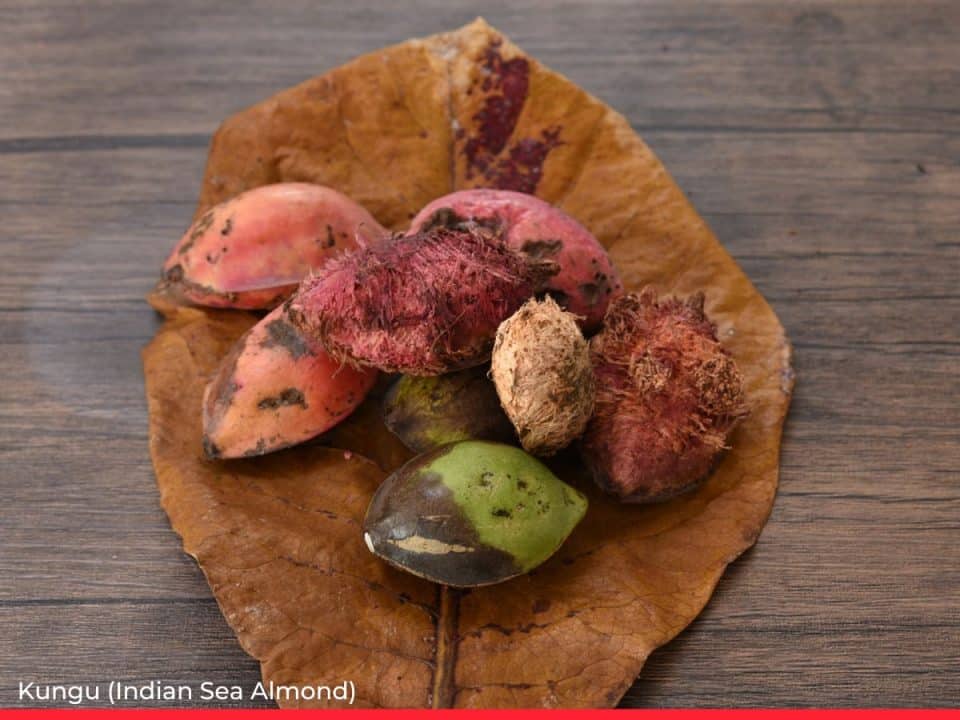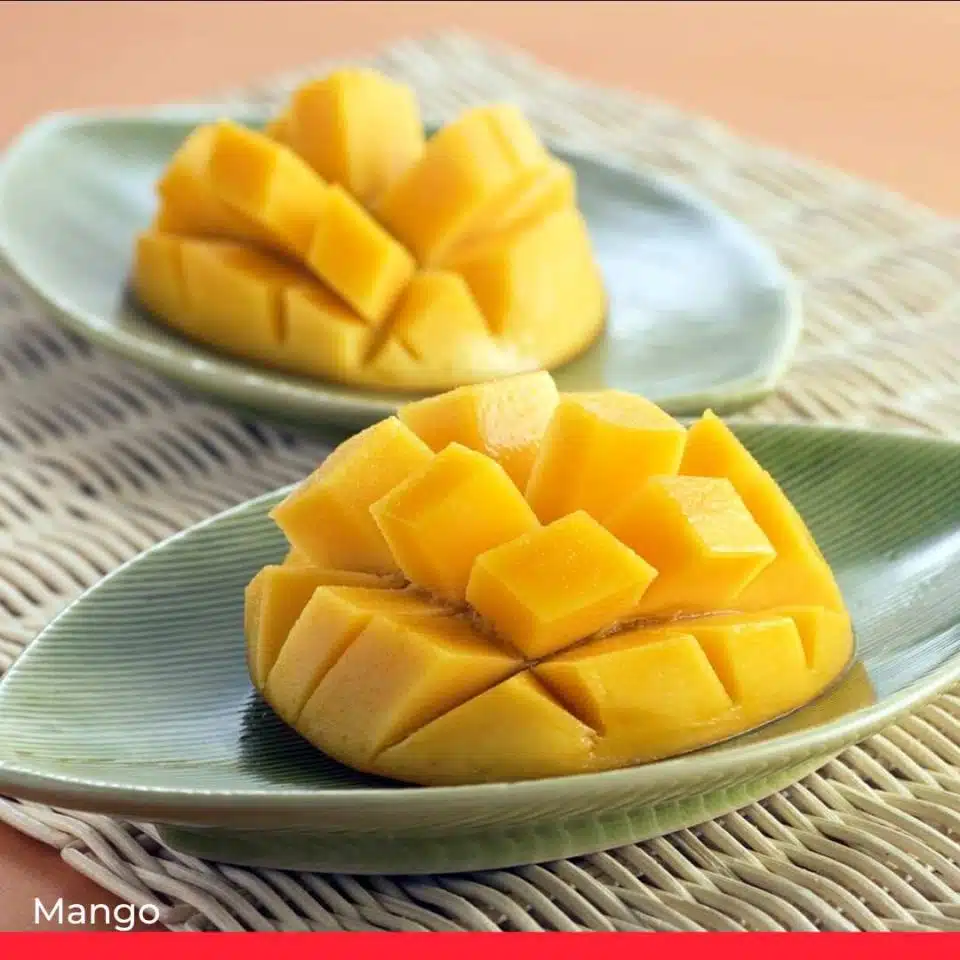As a tropical country, Tanzania enjoys its fair share of fruits all year round. With a mix of coastal landscapes, highlands, and lowlands, you would naturally expect to find a variety of fruits.
What makes Tanzania fruits the best is that most farmers still practice traditional fruit growing. So, you get to enjoy the most natural and organic fruits, with some offering the best flavors at their peak times. Here are the top 15 popular fruits grown in Tanzania.
1. Bungo (Rubber Vine)

Bungo, or mabungo (pl.), is native to tropical countries in East Africa, Madagascar, and Comoros. When mature enough to eat, the fruit features an orange outer and is usually sliced at the top to reveal the inner flesh.
The inner flesh is made of small cylindrical seeds that hold the flesh and are eaten by sucking on them. In Tanzania, younger children and women enjoy mabungo topped with a salt and red chili pepper powder mixture.
Ice-cold bungo juice is another popular beverage worth trying. When eaten as it is, bungo is faintly sweet and tangy but keeps you wanting more. As a juice, it boasts a unique flavor, somewhere between mango, orange, and pineapple juice. As people continue to experiment with flavors, Tanzanians have begun to incorporate mabungo in plenty of other culinary inventions. My favorite is bungo popsicles and bungo-flavored ice cream.
2. Ukwaju (Tamarind)

Ukwaju is a popular coastal fruit, typically used for cooking and to make juice. Ukwaju is naturally tangy and a favorite among pregnant women. However, when turned into juice, it is refreshing.
You can add sugar to the juice to undercut some of the acidity and tanginess. This unique tangy and acidic flavor profile of ukwaju is also what makes it an excellent seasoning for Swahili foods, especially seafood.
3. Zaitun (Zanzibar Olives)

Zaitun or Mizaitun (pl.) are native to Zanzibar and are typically enjoyed as fruits when they ripen. Before maturity, mizaitun are green in color. So, you’ll know it’s time to eat them when they turn yellow or purple.
Unlike Mediterranean olives, Zanzibar olives are larger with a sticky and oily texture and extremely sweet and delicious taste.
4. Mstafeli or Matopetope or (Wild Soursop or African Custard Apple)

Soursop called mstafeli (mastafeli pl.) in Mainland Tanzania and matopetope in Zanzibar grow naturally across various regions in Tanzania. While mstafeli has plenty of hardcore fans, it’s not a widely consumed fruit. Nonetheless, I totally recommend trying it when in Dar es Salaam or Zanzibar.
Due to its limited popularity, you will only find this fruit in larger markets in mainland Tanzania, for example, the famed Kisutu market in downtown Dar es Salaam. However, soursup is more common in Zanzibar and can be easily spotted along roadside fruit stands. This fruit is delicious with a fleshy texture and tastes like a ripe pear.
Tip: When in Zanzibar, also try the incredibly delicious matopetope juice.
5. Fenesi (Jackfruit)

Fenesi, or mafenesi (pl.), is native to Tanzania and grows across the entire country. This exotic fruit has a sticky and sleek texture with a chewy, yet, delicious and hearty flesh.
In Tanzania, jackfruit or fenesi flesh is usually consumed on its own as a snack or turned into an ultra-sweet juice.
6. Durian

Durian is a prominent and native edible fruit in Asian countries, such as Malaysia and Thailand. Interestingly, this large and spiky hard-shelled tropical fruit is also native to Zanzibar. While it resembles the fenesi or jackfruit, that’s where their similarities end.
Durian has a completely different taste profile and is usually eaten as a snack or used in cooking. But be warned: it is an acquired taste. It has a fleshy custard-like texture and is pretty delicious. However, you’ll have to get past its pungent smell to enjoy this fruit.
7. Shokishoki (Rambutan)

Like durian, shokishoki, or mashokishoki (pl.), is native to southeast Asia. However, it is also a popular native fruit in Zanzibar.
Rambutan is a close relative of the lychee and even tastes similar. This medium-sized and spiky red fruit has a sweet flavor with some faint acidity and a few hints of strawberry and grape-like flavor. It also has a floral aroma and can be enjoyed as a snack or used to make a sweet, refreshing juice.
8. Mbilimbi (Starfruit or Carambola)

Mbilimbi or bilimbi is a coastal fruit commonly grown in Zanzibar, although you can also find a few in coastal mainland regions such as Dar es Salaam and Pwani. Mbilimbi is called starfruit in English on account of its star shape. When you slice the fruit, you get perfect star-shaped slices.
Mbilimbi is extremely tangy and acidic while its texture is soft. It is also effective at controlling nausea due to its high acidity and tangy taste. While some people love bilimbi as a snack, locals also use it to make a local pickle that they eat as a condiment.
9. Muwa (Sugar Cane)

A classic coastal fruit, muwa, or miwa (pl.), is a favorite with schoolchildren. It’s not uncommon to find a small child fiddling around with a whole stick of muwa while playing. You can also find cubed and ready-to-eat freshly packed miwa at roadside stands or supermarkets.
However, the most popular muwa product on coastal Tanzanian streets is the freshly squeezed ice-cold juisi ya miwa (sugarcane juice). It is a perfect beverage for quenching the intense Dar es Salaam thirst!
Editor’s Note: Sugarcane juice is also a popular beverage in Guyana, Brazil, and throughout the Caribbean – all of these having with a significant African heritage. Sugarcane cultivation and the production of sugarcane-based products have historical roots in these regions, often linked to the transatlantic slave trade and the labor of African slaves on sugar plantations.
10. Kungu (Indian Sea Almond)

Kungu, or makungu (pl.), is a fruit of the mkungu or Indian almond tree native to tropical countries, particularly south Asia, Madagascar, Seychelles, and some portions of East Africa, including mainland Tanzania and Zanzibar. It is not especially common across the country, but these small fruits are popular with locals in coastal areas.
They have a perfect balance of sweet and tangy and taste almost like guavas. Kungu fruits, particularly their seeds, are also roasted and used in cooking due to their delicious taste and powerful medicinal properties.
Not many places sell kungu as they are not widely popular. Instead, you are more likely to find them on the actual trees. If your host has a mkungu tree in the yard, ask for a taste!
Interesting fact: While not dangerous, you will notice your eyes turn red when you eat a lot of kungu fruits.
11. Dafu (Baby Coconut)

Tanzania wouldn’t be a tropical paradise without the famed tropical fruit, coconuts. Typically growing in the coastal regions and Zanzibar archipelago, the dafu, or madafu (pl.), should be on your list of fruits to taste when you visit Tanzania. Dafu is a common fruit consumed in Zanzibar and coastal regions.
Dafu (baby coconut) should not to be confused with nazi, which refers to a mature coconut. Nazi is typically sold in open markets or grocery stores. You can use the mature coconut water (maji ya nazi) for drinking or cooking while the flesh (nyama ya nazi) is grated to create coconut milk or cream, coconut shavings, or dried coconut powder for baking.
Baby coconuts are sold by cycling street vendors and in juice shops, cafes, and grocery stores for you to enjoy the refreshing water. Once done drinking the water, you can enjoy the flesh.
The best part of Tanzanian coconuts is that they are harvested daily and they are a popular beverage. So, you are always guaranteed to find a fresh one, especially when you purchase it from street vendors on bicycles.
12. Ubuyu (Baobab)

Ubuyu is a quintessential coastal Tanzanian fruit and holds great significance in the culinary culture. Even the long-lived mbuyu tree is believed to hold spiritual significance in Swahili culture and is typically incorporated in a range of spiritual events!
Ubuyu fruit is often eaten on its own, despite being extremely tangy and earthy, due to its powerful medicinal benefits. The fruit is also commonly candied and dyed to make the popular ubuyu (candied baobab snack). Further, ubuyu fruit is turned into a powder and mixed with water for a refreshing and medicinal drink.
But, that’s not all! Over the years, Tanzanians have gotten creative with this tropical fruit, using it to craft a range of culinary inventions. You can even find strawberry-flavored candied ubuyu, ubuyu ice cream, and ubuyu cake.
13. Zabibu (Grapes)

Boasting the perfect desert-like weather and conditions, Dodoma is home to Tanzanian zabibu, or mzabibu (pl.). In fact, this region is also the wine-making capital of the country as it is where most of the country’s grapes come from. Dodoma grapes are small in size and have a deep purple-to-black color.
However, they are extremely sweet and slightly tangy. They make great snacks and a deliciously refreshing juice. Dodoma grapes are at their peak season from February through March and August through September, when they boast the best flavors.
Interesting fact: Tanzania produces a wide range of good wines using grapes from the Central Tanzania region, Dodoma (Dodoma city in the Dodoma region is also the nation’s capital city). Make sure to grab a bottle or two to sample them and go on a vineyard tour when you visit the region.
14. Ndizi Mbivu (Ripe Bananas or Banana Fruits)

Tanzania is a significant banana producer and several varieties are native to the country. In addition to cooking bananas, the green ndizi bukoba, or mbeya au mshale, and plantain (ndizi mzuzu) native to the northwest, northeast, and southern islands, different types of banana fruits (ndizi mbivu) grow in this tropical country as well.
Tanzania produces them all! From the short and sweet yellow bananas to the long and green to yellow semi-sweet to sweet bananas, depending on the region. However, you can find any type of banana you want at any market across the country, whether in Dar es Salaam, Arusha, Mwanza, or Zanzibar, to name a few.
15. Embe (Mango)

Like ripe bananas, a wide range of embe, or maembe (pl.), grow across Tanzania. Whether in Zanzibar, Dar es Salaam, the southernmost tip of Tanzania, or the north, you are guaranteed to find mangoes growing. You will enjoy these organic tropical fruits most during their peak harvest period (in late November through December) when ripe and ultra sweet.
Varieties include embe dodo, a medium-sized and ultra sweet variety, or smaller mango varieties with extremely juicy, sweet flesh.
Tip: A coastal delicacy, try unripe to semi-ripe mango sliced into strips and topped with a salt and red chili pepper powder mixture when you visit Dar es Salaam, Pwani, Tanga, or Zanzibar. You can also find a range of other mango-based food items, such as mango pickle, a sweet, savory, tart, and spicy condiment.
Final Thoughts: Honorable Mentions
As evident from its tropical nature, Tanzania is a haven for fruit lovers. In addition to its unique fruits, you will also find a range of common tropical fruits growing all year round. As always, you will be impressed by the ultra-sweet and organic nature of most fruits grown in Tanzania.
Other common tropical fruits you will find in this East African country include:
- Nanasi or mananasi (pl.) (pineapple)
- Parachichi or maparachichi (pl.) (avocado)
- Tikiti or matikiti (pl.) (watermelon)
- Pesheni or mapesheni (pl.) (passionfruit)
- Chungwa or machungwa (pl.) (oranges)
- Chenza or machenza (pl.) (tangerines)
- Pera or mapera (pl.) (guava)
- Papai or mapapai (pl.) (papaya)
- Komamanga or makomamanga (pl.) (pomegranate)
Related: The Most Popular Foods in Zanzibar
Related: The Most Popular Foods in Tanzania
Related: 16 African Fruits You Need to Try
The post 15 Popular Fruits Grown in Tanzania appeared first on Chef's Pencil.
from Chef's Pencil https://ift.tt/K80f6t1
via https://chefsspenncil.blogspot.com

No comments:
Post a Comment